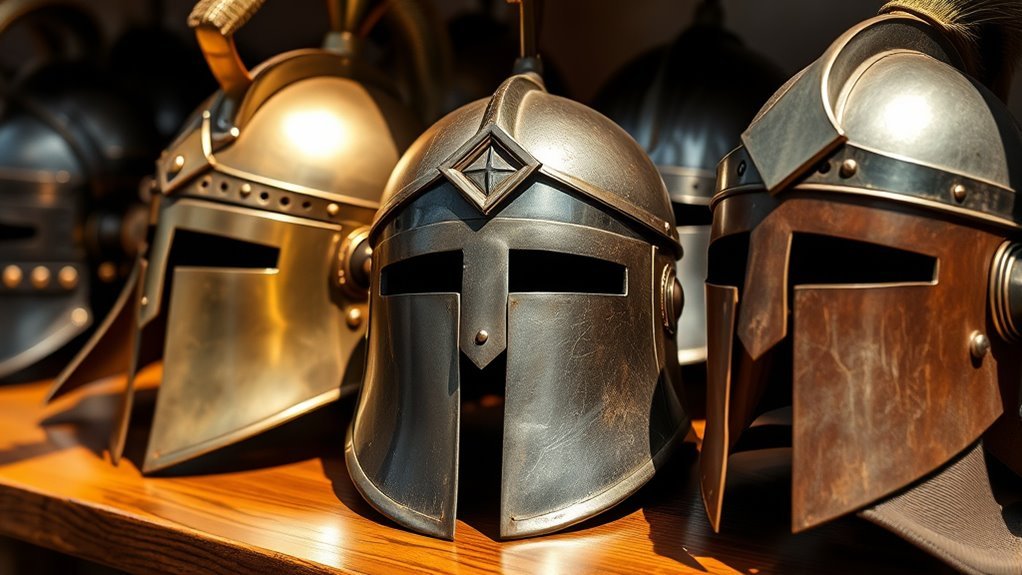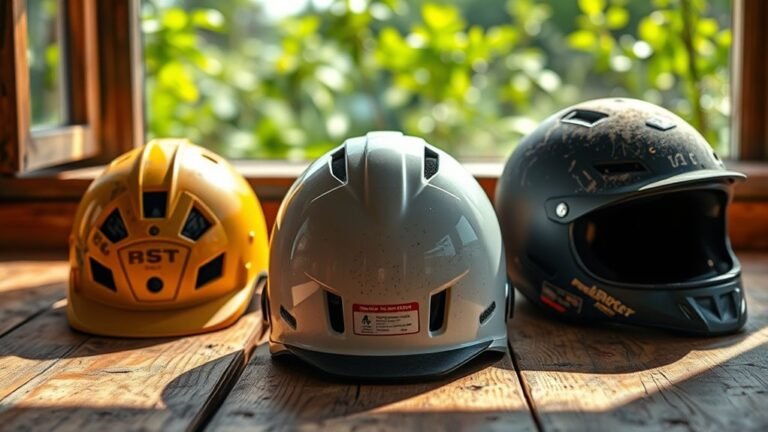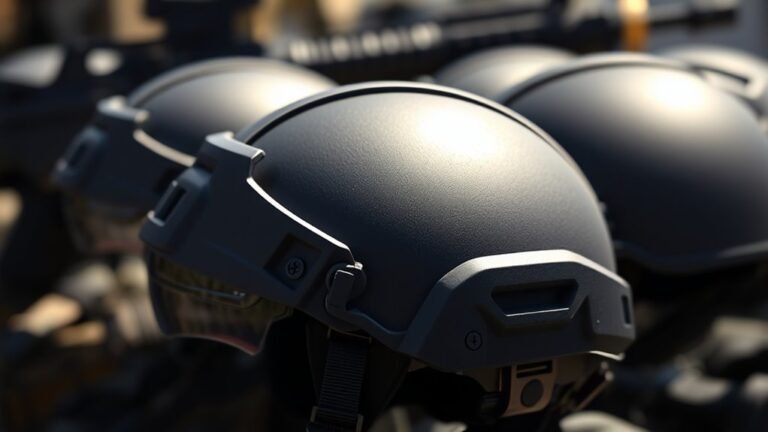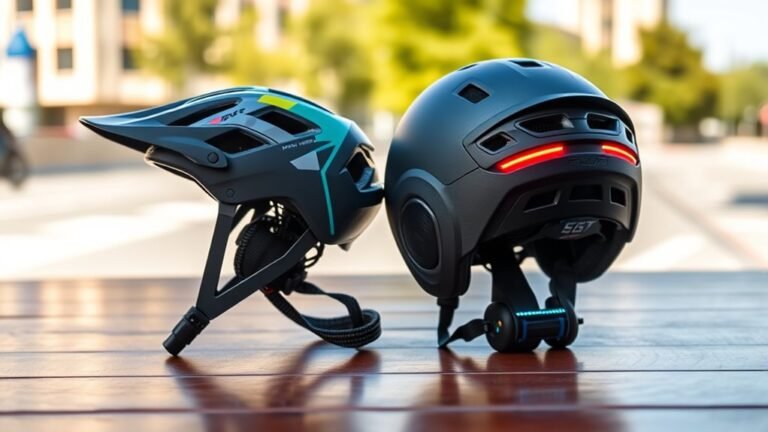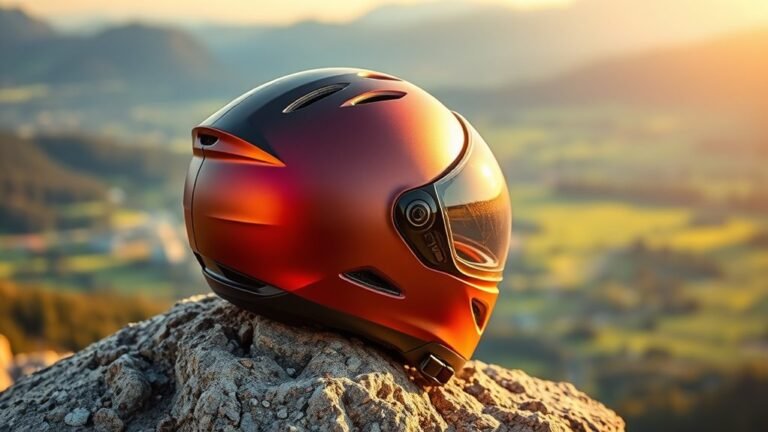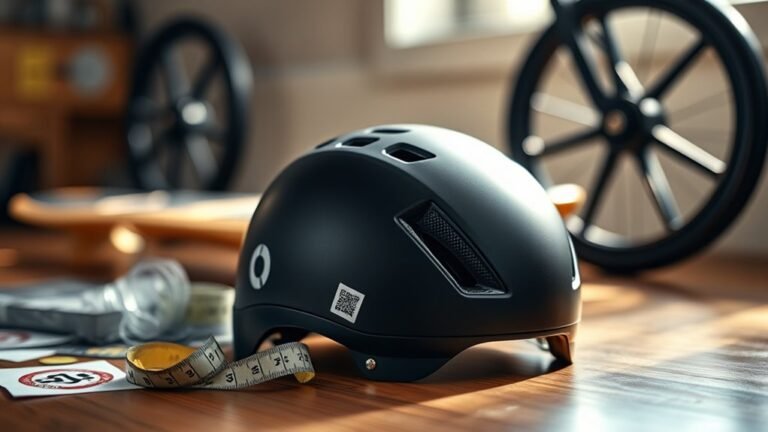History of Military Helmet Designs
The history of military helmet designs reflects significant advancements influenced by warfare and technology. Ancient helmets evolved from bronze and leather to more complex forms, like the Roman galea, which combined protection with mobility. The introduction of gunpowder necessitated a reevaluation of designs, shifting focus to thicker materials and streamlined shapes. Modern helmets feature composite materials and integrated communication systems, enhancing soldier effectiveness on the battlefield. Exploring further, you’ll uncover even more remarkable innovations and the future of helmet technology.
Ancient Helmets: The Origins of Head Protection
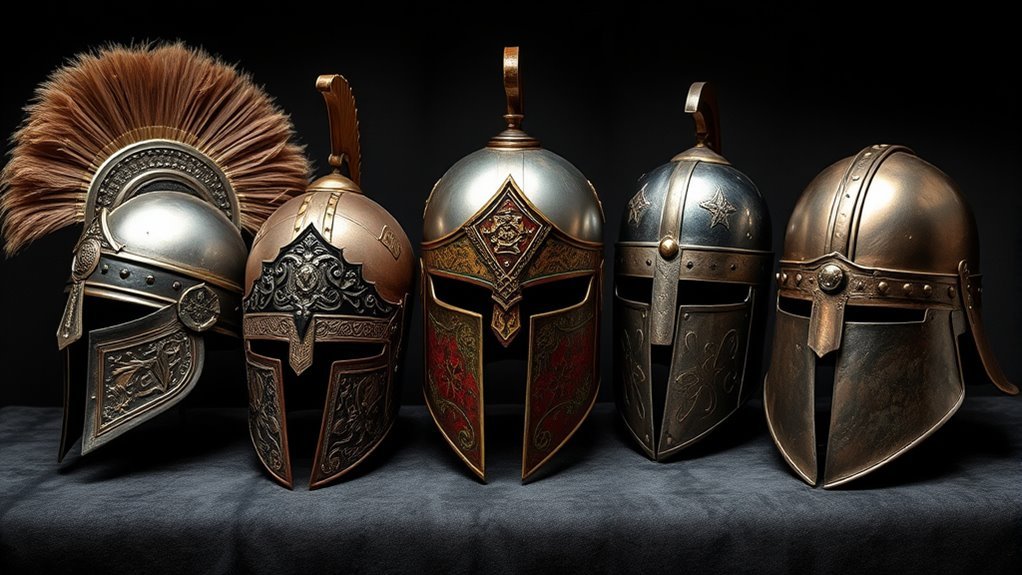
Although head protection has evolved considerably over the centuries, the origins of ancient helmets reveal a fascinating blend of necessity and innovation in warfare. Early designs varied markedly across cultures, influenced by the materials available and the specific combat conditions faced by warriors. For instance, the use of bronze in Mediterranean regions led to sturdy helmets, while leather was favored in nomadic societies for its lightweight properties. Cultural influences shaped not only the functionality of these helmets but also their aesthetics, reflecting the values and beliefs of the societies that crafted them. As you explore these ancient designs, you’ll see how they laid the groundwork for future advancements, underscoring the importance of head protection in the quest for survival and dominance on the battlefield.
The Rise of the Roman Galea
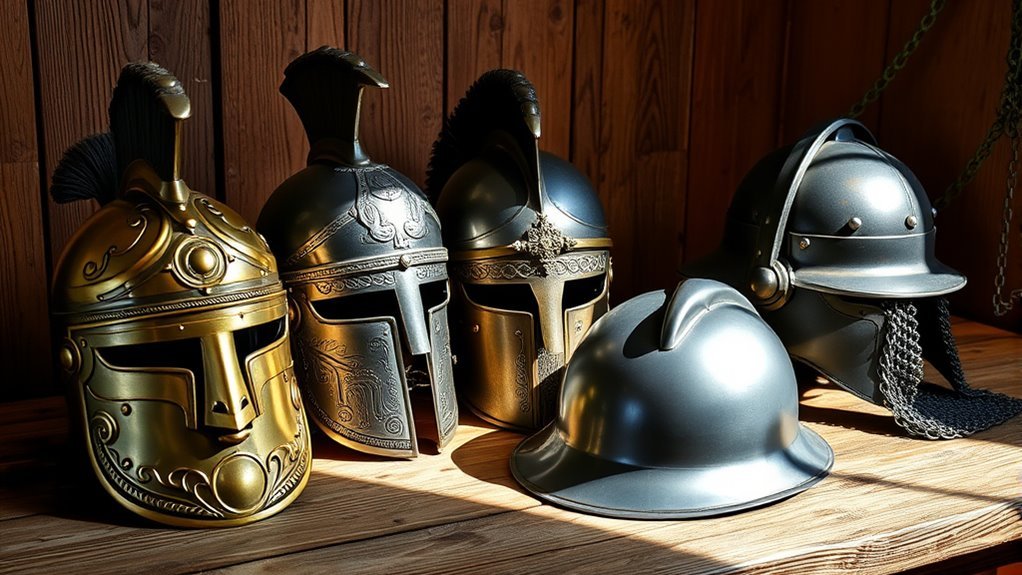
As ancient helmets evolved, one notable design emerged: the Roman galea. This helmet featured a distinctive galea structure, often crafted from bronze or iron, providing both protection and a degree of mobility. Its characteristic high crest and cheek guards not only safeguarded soldiers in battle but also served as a powerful symbol of military might and status. The galea’s design reflected the Roman ideals of strength and discipline, embodying the identity of a warrior. As you explore the rise of the galea, consider how its helmet symbolism transcended mere utility, becoming an emblem of the Roman Empire’s military prowess. This fusion of form and function laid the groundwork for future developments in helmet design, influencing countless generations.
Medieval Armor: The Transition to Full-Face Protection
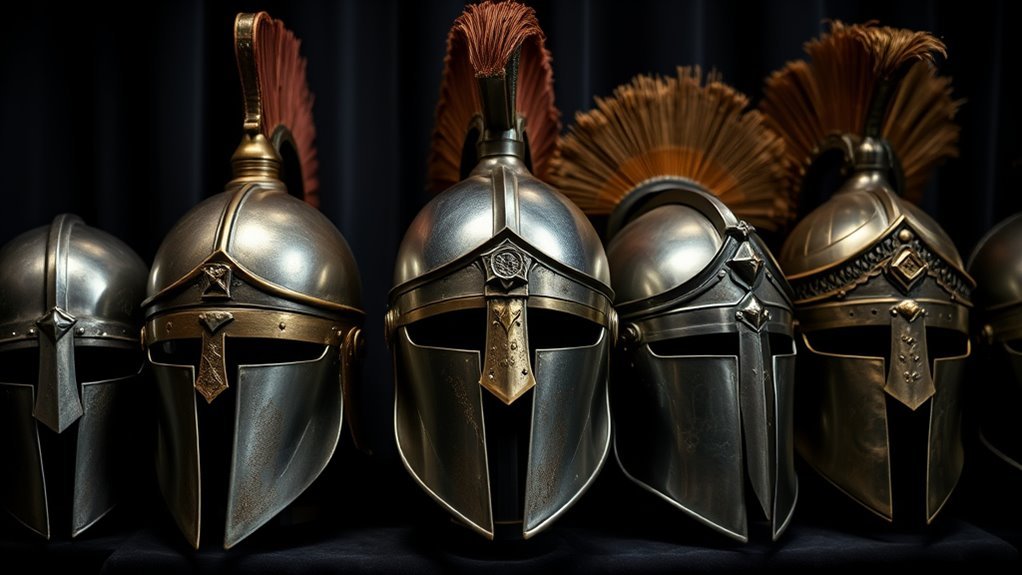
With the advent of the medieval period, the evolution of helmet design took a significant turn as the need for full-face protection became essential. Warriors sought extensive defense against various weaponry, leading to innovations in helmet construction, particularly with plate armor.
- The integration of visors allowed for enhanced visibility while maintaining protection.
- Articulated designs emerged, combining mobility with coverage.
- Materials advanced, enabling lighter yet stronger helmets.
These developments not only improved survivability in combat but also reflected the era’s growing sophistication in warfare. The visor functionality became a vital feature, allowing knights to engage in battle without sacrificing safety. As a result, full-face helmets established a new standard for personal armor, embodying the ideals of protection and freedom on the battlefield.
The Impact of Gunpowder on Helmet Design
The introduction of gunpowder fundamentally transformed military tactics, necessitating a reevaluation of helmet design to address the new threats posed by firearms. With gunpowder advancements, the lethality of weapons increased, leading to significant helmet modifications. Traditional designs, often focused on protection against melee weapons, became inadequate. As bullets could penetrate metal, helmets were re-engineered to incorporate thicker materials and streamlined shapes, minimizing the risk of fatal head injuries. Additionally, visors were adjusted or eliminated to enhance visibility and mobility on the battlefield. These changes reflected a broader understanding of combat dynamics, prioritizing both protection and practicality. Ultimately, the impact of gunpowder on helmet design marked a pivotal shift in military strategy, emphasizing adaptability in the face of evolving warfare technologies.
World Wars and the Introduction of Modern Materials
During the World Wars, advancements in material science greatly transformed military helmet design. As conflicts evolved, the integration of modern materials not only enhanced the structural integrity of helmets but also improved overall soldier safety. Understanding these changes reveals how technological innovation directly impacts combat effectiveness and protection.
Advancements in Material Science
As military conflicts escalated during the World Wars, innovations in material science became essential for developing more effective helmet designs. This period marked a shift towards the use of advanced materials, markedly enhancing soldier protection without compromising mobility.
- Composite materials: These offered improved strength-to-weight ratios, allowing for helmets that could withstand greater impacts.
- Lightweight alloys: Innovations in metallurgical engineering provided options that reduced overall helmet weight while maintaining durability.
- Thermoplastics: These materials enhanced comfort and fit, adapting better to varying climates and conditions.
These advancements not only elevated the level of safety for soldiers but also paved the way for further developments in military gear, emphasizing the importance of material science in combat readiness.
Design Evolution During Conflicts
While military conflicts drove the urgent need for enhanced soldier protection, helmet designs underwent significant transformations throughout the World Wars. Early in World War I, design influences emphasized steel for durability, leading to the introduction of the iconic Brodie helmet. As combat scenarios evolved, the need for better fit and comfort became apparent, prompting innovations like the American M1917 helmet, which featured a more streamlined shape. By World War II, advancements in materials allowed for lighter and more effective designs, such as the M1 helmet, which incorporated a fiberglass outer shell. These changes reflected a growing understanding of the diverse combat scenarios soldiers faced, ultimately shaping a new era of military headgear focused on both protection and practicality.
Impact on Soldier Safety
The introduction of modern materials in military helmet design markedly enhanced soldier safety during the World Wars, addressing the increasing demands of combat. These advancements not only improved helmet safety but also focused on design effectiveness, ensuring that soldiers could rely on their gear in life-threatening situations.
- Lightweight composites allowed for better mobility without compromising protection.
- Improved padding systems enhanced comfort and reduced blunt force trauma.
- Advanced ballistic materials provided superior resistance to projectiles and shrapnel.
As you reflect on these innovations, it becomes clear that the shift towards modern materials was pivotal in transforming helmets from mere headgear into essential life-saving equipment, ultimately shaping the battlefield experience for soldiers.
Contemporary Innovations in Military Headgear
Contemporary military headgear has seen significant advancements, particularly with the use of advanced materials that enhance durability while reducing weight. These innovations not only improve protection but also allow for the integration of communication systems, facilitating seamless coordination among troops. As you explore these developments, consider how they impact both functionality and soldier safety in the field.
Advanced Materials Utilization
As military operations evolve, the demand for innovative materials in headgear has surged, leading to significant advancements in helmet design. Today’s helmets utilize cutting-edge technologies to enhance protection and performance, primarily through the incorporation of carbon composites and ballistic fibers. These materials provide lightweight yet robust solutions, ensuring soldiers can maintain agility without compromising safety.
- Carbon Composites: Offer high strength-to-weight ratios, improving mobility.
- Ballistic Fibers: Enhance resistance to penetration, critical in combat situations.
- Advanced Coatings: Provide additional protection from environmental factors and reduce thermal signatures.
Such innovations reflect a commitment to enhancing soldier survivability while promoting the freedom of movement essential for modern warfare.
Integrated Communication Systems
With advancements in materials enhancing protection and mobility, modern military helmets are increasingly integrating sophisticated communication systems to support tactical operations. This communication integration allows soldiers to relay critical information in real-time, enhancing situational awareness and coordination. Helmet technology has evolved to include built-in headsets and noise-canceling features, which enable clear communication even in chaotic environments. Additionally, integration with other systems, such as GPS and battlefield management tools, guarantees that you’re not only protected but also connected. These innovations streamline communication, reducing the risk of miscommunication and improving overall mission effectiveness. As military operations become more complex, the role of integrated communication systems in helmet design will continue to be pivotal for enhancing operational freedom and efficiency on the battlefield.
Frequently Asked Questions
What Materials Were Used in Ancient Helmet Construction?
In ancient times, nearly 70% of helmets were crafted from bronze, showcasing its durability and effectiveness. You’ll find that leather construction was also common, often used for lighter helmets or as linings, providing comfort and additional protection. The combination of these materials allowed soldiers to balance weight and defense during battle. Each design choice reflected the tactical needs of the era, emphasizing the importance of innovation in warfare.
How Did Different Cultures Influence Helmet Designs?
Different cultures considerably influenced helmet designs through their unique cultural aesthetics and practical needs. As you explore design evolution, you’ll notice how elements like ornate decorations from the Romans contrasted with the simpler, functional styles of the Spartans. Each society’s values and warfare strategies shaped helmet features, resulting in variations in form and function. This interplay of cultural influences showcases the diverse approaches to protection and identity on the battlefield.
Were Helmets Purely Functional or Did They Have Symbolic Meanings?
Helmets weren’t just practical gear; they carried a wealth of symbolic significance. You’ll find that many designs served as cultural representations, reflecting the values and beliefs of the societies that created them. While they protected soldiers in battle, they also conveyed status and identity, acting as a badge of honor. So, when you think of helmets, remember they’re more than mere armor—they’re a canvas for the stories of their people.
How Are Modern Helmets Tested for Safety and Effectiveness?
Modern helmets are rigorously tested for safety and effectiveness through impact testing, ensuring they can withstand various forces. They’re evaluated against design standards set by organizations like the National Institute of Justice. These tests simulate real-life scenarios, measuring how well a helmet protects against blunt force trauma and penetration. By adhering to these standards, manufacturers can guarantee that their helmets not only meet safety requirements but also provide reliable protection for users in critical situations.
What Role Do Helmets Play in Psychological Warfare?
Helmets play a significant role in psychological warfare by serving as powerful symbols of strength and authority. When you see a soldier donning a helmet, it can evoke a sense of intimidation in opponents, showcasing an unwavering commitment to combat. This helmet intimidation can demoralize enemies, causing them to doubt their own capabilities. Additionally, the symbolism of helmets can rally troops, fostering unity and resilience in the face of adversity, which is essential for maintaining morale.
